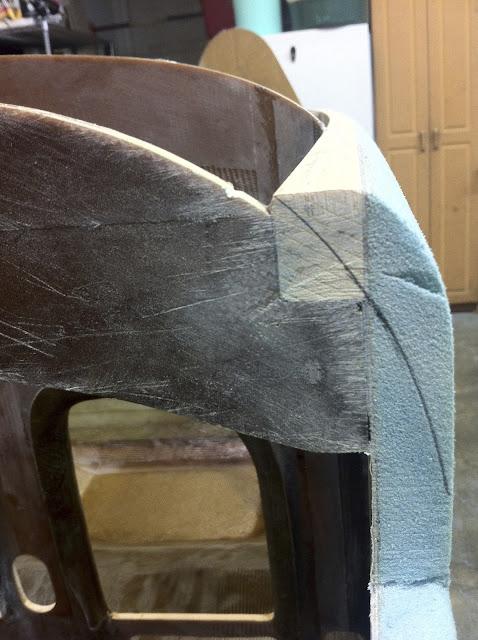Trimming the top longeron (1.0 hr)
Looking back at it now it makes perfect sense, but the all knowledgable hindsight would require some more time before making its presence felt.
And so it is, that my balding spot received 24 more hours of vigorous scratching, thanks in part to some slightly ambiguous drawings.
I shall recap my confusing journey for the benefit of future travelers, so that they might not be bogged down by such pesky details.
It all started with the drawings on page 7-1, section A-A in particular...
 |
Page 7-1 |
... and a suspicious warning in CP#27 (LPC #50) not to follow such path, but to rely instead on a different chart, the life size A-2...
 |
| 1:1 scale A-2 drawing |
... regrettably, the more I stared at it, the less sense it made. For one thing, it was a very different view altogether, and then there was no indication whatsoever of what had changed.
Struggling to extract a 3D image out of the 2D drawing of the fuselage side view, I eventually understood the issue, but obviously not its magnitude, thus missing out on the one all important detail that eventually became the focus of my mad search for truth.
The only obvious thing to me at the time, was that shaving the longeron should begin 6.5” (16.5 cm) from the front of F-28.
 |
| Making sense of the drawing |
 |
| Outlining the course of action |
The first alarm bells started going off right as I sketched the proposed trim line, but hear them I did not, captivated as I was by the strange looking intersection between the longeron and F-28.
Strike one!
 |
| Hmm... something's up! |
While a psychologist would certainly have a fancier name for it, I will just describe my thought process as denial, and rationalization. For one thing, it was only off by a quarter inch, and then, it was probably due to my F-28 modifications anyway.
With the argument over whose fault it was won, I set off to the manual task of sanding wood and foam. Unbelievably, the final result resembled exactly what I set out to achieve, but by this time I had grown unhappy with the unsightly notch my work had left on top of the plane.
 |
| Hideous notch in plain view |
I could have easily blended sidewall, longeron, and F-28 seamlessly, but only by further reducing the longeron cross section...
 |
| Post-it note brainstorming |
... and forcing a dip in the top of the longeron that was definitely not in the plans.
A quick poll of my friends yielded no easy breakthrough, with opinions ranging from “I don’t know”, to “it doesn’t really matter”. Growing increasingly frustrated, I resorted to searching through my photo archive, to check out what other builders had done about it in the past.
Wouldn’t you believe it that my good friend Walter’s fuselage sported the odd dip?
Alarm bells going off again!
Huh?
 |
| Forward longeron sanded to dip |
 |
| Beautifully straight top of longeron |
Poor thing! Surely he must have gotten confused as well, and made the same mistake I was trying so hard to avoid!
Strike two!
So, there I was, with a beautifully shaped fuselage that strangely did not fit.
Luckily for me, a series of emails that forced me to explain multiple times to others, and to myself, where the trouble lay, eventually helped turn the tide of insanity that nearly drowned me.
Saved from striking out, I finally realized that a dip was exactly what the drawing A-2 was calling for all along, had I just "listened" to it more intently.
 |
| So that's what that was! |
The new section A-A looked more like this...
 |
| Finally getting the point |
Nothing left to do but grab the sanding block, and get back to work.
Eagle-eye Walter was right once again!













